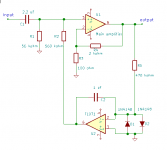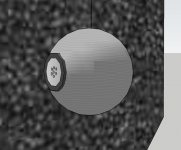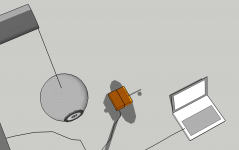Good. Me neither really but I do strive for as clean signal path as absolutely possible. In this case leaving out the caps is a case of sub-optimisation i.e. gone to the length being contra productive.
//
I feel the same way about offset servos, they are frequently in the signal path "technically" so I would go with a coupling cap, much simpler.
Scott, what real components would you use for Q1, Q2, C3 and C4 in fig 10 circuit?
What -3 dB point gives for the C3/C4?
And a shot at R3?
Marcel - 47 uF, I suppose it sets a lower FR -3 dB point - where does it end up?
These OK? https://www.mouser.se/ProductDetail/WIMA/MKS4B054706F00MD00?qs=2G4irm/qADxvhfvbNgDiQw==
//
What -3 dB point gives for the C3/C4?
And a shot at R3?
Marcel - 47 uF, I suppose it sets a lower FR -3 dB point - where does it end up?
These OK? https://www.mouser.se/ProductDetail/WIMA/MKS4B054706F00MD00?qs=2G4irm/qADxvhfvbNgDiQw==
//
Last edited:
Those 47 uF and 100 uF capacitors just set a frequency above which the bootstrapping gradually kicks in. As it kicks in very gradually, I chose that frequency quite low, around 1 Hz, so the bootstrapping will already be quite effective at the lowest audio frequencies. The main signal path is DC coupled, so the microphone and whatever high-pass you apply on the digital side will determine where the bass rolls off.
Rather than spending thousands of euros on a box with 500 film capacitors, I would just use electrolytic capacitors. They are only meant to reduce second-order effects anyway.
Rather than spending thousands of euros on a box with 500 film capacitors, I would just use electrolytic capacitors. They are only meant to reduce second-order effects anyway.
I feel the same way about offset servos, they are frequently in the signal path "technically" so I would go with a coupling cap, much simpler.
I sometimes combine coupling capacitors and DC servos in the same design. For example, the attachment shows what I use in my main amplifier (the upper op-amp is actually not an op-amp, but a nearly discrete power amplifier). It can work quite well, the only disadvantage is that neither people who dislike coupling capacitors nor people who dislike DC servos will like the design 😉
Attachments
Last edited:
Ok! I wasn't planning buying a box of them - just wanted to point to the component - unfortunate it was a version sold in bulk 🙂
//
//
Scott, what real components would you use for Q1, Q2, C3 and C4 in fig 10 circuit?
What -3 dB point gives for the C3/C4?
And a shot at R3?
//
Anything like the BC550/560 series works.
C3 and C4 are just coupling caps to the next stage so it depends on the input impedance of it. I like large resistors and small caps.
R3 depends on the capsule current 1.5V @ 1mA is 1K. It is not super critical.
The "input" in Fig. 10 is normally the grounded capsule pin. You can use it as an input that uses the capsule capacitance as coupling to the gate of the FET and test the circuit with a signal generator. In a circuit with optional bootstrapping you can test the performance with and without it electrically not acoustically (a temporary tape over the mic face helps here).
Thanks! "I like large resistors and small caps." - this despite, as I understand it, a potential noise penalty?
//
//
This idea has made me think about how to interface an electret capsule with the input of an ADC. Would a line driver from the AD SSM21xx series be appropriate? Of course it doesn't have much voltage gain, but could serve to buffer and balance the output of the mic capsule into a format that can drive an ADC. Quiet enough?
It seems that the AD component is for song microphone as it contains compressor, AGC, limiters etc... i.e. it's an other basic application that what I seek in the sense that this thread is about a purist, no frills, lowest possible distorsion, instrumental type, super transparent solution.
I'm sure its good for stage.
THD+N however is in % territory.
//
I'm sure its good for stage.
THD+N however is in % territory.
//
Last edited:
TI are efficient... DHL call on my door this morning 🙂 but I was out so could not receive it but it ends up in a store 2 minutes away so...
//
//
Thanks! "I like large resistors and small caps." - this despite, as I understand it, a potential noise penalty?
//
Can be designed around, I used 50M (actually 3 22M in series) and 1000pF PS cap in one mic. You just need to do the computation/simulation of the whole noise budget.
It seems that the AD component is for song microphone as it contains compressor, AGC, limiters etc... i.e. it's an other basic application that what I seek in the sense that this thread is about a purist, no frills, lowest possible distorsion, instrumental type, super transparent solution.
I'm sure its good for stage.
THD+N however is in % territory.
//
What were you writing about here?
What about the "eyeball" mic? 🙂 This idea I have taken from a pair of subs I built which in turn was inspired by B&W "ball subs". Apparently, vibration in a sphere tend to go around in the walls rather than vibrating the whole sphere. So I hope with this to have a very silent platform for the capsules. I ordered also the bespoke rubber grommets. I hope to suspend the eyeballs in perhaps springs or the like. Treating the innards with damping paint or other treatment... The only thing I like to move is the membrane...
But will there be diffraction or reflections from a big "tip" of the mic?
//
But will there be diffraction or reflections from a big "tip" of the mic?
//
Attachments
Last edited:
I would suspect a boost in the upper range, tho how much due to a sphere I don't know. Most measurement mics are on the end of a long skinny tube for a reason.
I can borrow an Earthworks M30 mic for "calibration"... depending a little on the deviation I will either do a electrical compensation or do it digitally in post.
Sharing my excitement and enthusiasm after fetching the parcel. Mic capsules also on its way as is a set of components. Power is a bit uncertain... batteries, stabs....
//
Sharing my excitement and enthusiasm after fetching the parcel. Mic capsules also on its way as is a set of components. Power is a bit uncertain... batteries, stabs....
//
Attachments
- Home
- Source & Line
- Digital Line Level
- Fixed gain field recorder?



